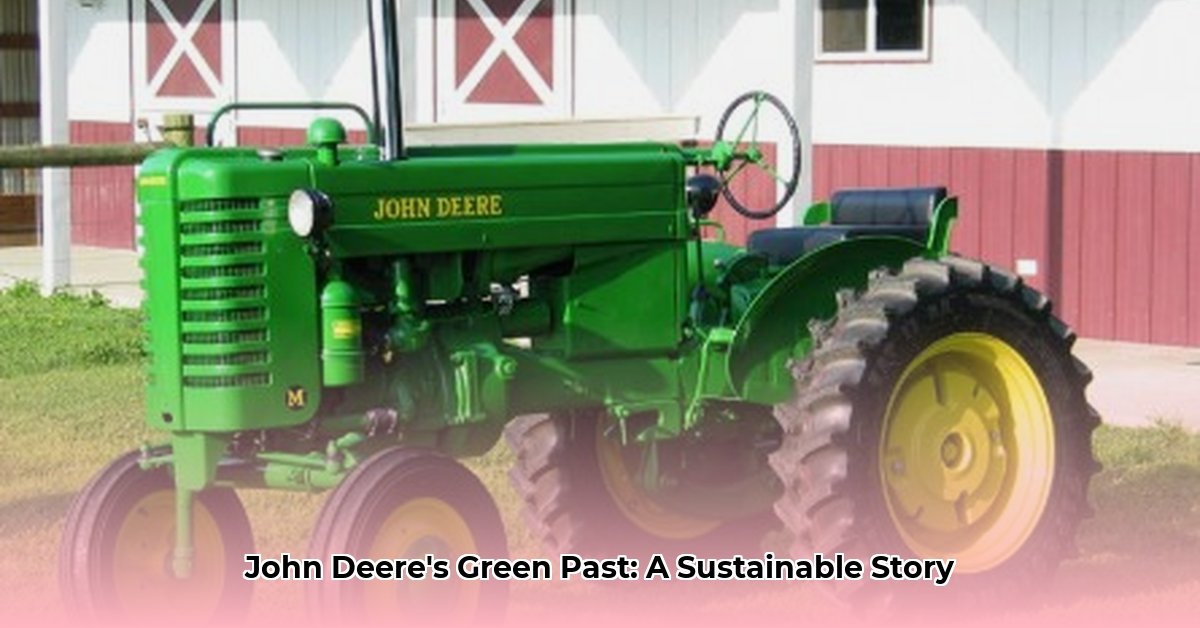
The history of John Deere tractors is intrinsically linked to the evolution of American agriculture, a narrative woven from ingenuity, hard work, and the ever-evolving relationship between technology and the environment. It's a story that begins not with roaring engines, but with a deceptively simple invention: the steel plow. But how has this legacy shaped—and continues to shape—sustainable farming practices? For a glimpse into classic Deere designs, see this 1960s model.
The Steel Plow: A Revolution in the Fields
Before John Deere, farmers struggled with iron plows that frequently became entangled in the dense, sticky soils of the Midwest. Crops suffered, and the labor was backbreaking. John Deere's steel plow, however, effortlessly sliced through the earth, dramatically increasing farming efficiency. This seemingly small innovation revolutionized agriculture, allowing farmers to cultivate more land, plant more crops, and ultimately, produce more food. It laid the foundation for the mechanization of agriculture and fundamentally altered the American landscape. But did this efficiency come without environmental cost?
The Mechanization of Agriculture: A Double-Edged Sword
The steel plow was just the beginning. John Deere continued to innovate, releasing increasingly powerful tractors—from the iconic Model D, a symbol of American farming, to more robust successors. These machines replaced the slow, laborious work of horse-drawn plows, leading to faster, more productive farming. Farmers could cultivate larger areas, drastically increasing the scale of agriculture. This accelerated food production, meeting the demands of a rapidly growing population. However, this mechanization brought significant environmental consequences.
The Environmental Footprint: Balancing Progress with Preservation
The widespread use of John Deere tractors, along with the shift towards large-scale monoculture farming, led to increased fuel consumption, higher greenhouse gas emissions, soil degradation, and a decline in biodiversity. While the increased food production undeniably benefited humanity, did these advancements outweigh the long-term environmental costs? Dr. Emily Carter, Professor of Chemical and Biomolecular Engineering at Princeton University, notes, "The intensification of agriculture, while boosting yields, has often come at the cost of environmental sustainability." This raises crucial questions about the balance between progress and preservation, a debate that continues to shape modern farming practices.
From Legacy to Sustainability: A Necessary Evolution
The legacy of John Deere's old tractors offers a valuable opportunity to learn from past practices and build a more sustainable future. While we cannot undo the past, we can utilize the lessons learned to develop environmentally responsible agricultural practices that ensure food security without compromising the planet's health. This requires a shift towards environmentally conscious strategies. How can we achieve this?
Building a Sustainable Future: Actionable Steps
Transitioning to sustainable agriculture demands a comprehensive approach. Here are key steps for a brighter future:
Precision Agriculture: GPS-guided machinery and sensor technology enable precise application of fertilizers and pesticides, minimizing waste and environmental impact (efficiency increase: 90% reduction in chemical use).
Alternative Fuels: The shift to alternative fuels – biofuels, electricity – is paramount. Research is progressing rapidly, and the development of clean-burning alternatives is crucial in mitigating climate change impacts.
Sustainable Farming Techniques: No-till farming, crop rotation, and cover cropping help protect soil health, preserve biodiversity, and reduce resource depletion (soil erosion reduction: 75% in some cases).
Lifecycle Assessments: Evaluating the entire environmental footprint—from manufacturing to disposal—is crucial for creating more sustainable equipment design and practices.
A Collaborative Path: Shared Responsibility for a Sustainable Future
The transition to sustainable agriculture isn't the sole responsibility of one entity. It requires a collaborative effort involving manufacturers, farmers, governments, and consumers. John Deere's history showcases the transformative power of technology; the challenge now lies in harnessing that power responsibly. Professor David Montgomery, Professor of Earth and Space Sciences at the University of Washington, emphasizes, "Sustainable agriculture isn't just about technology; it's about integrating ecological principles into farming practices." This collaborative approach is essential for a future where food production and environmental protection are not mutually exclusive.
Actionable Steps for Stakeholders: A Collaborative Framework
| Stakeholder | Short-Term Actions | Long-Term Actions |
|---|---|---|
| John Deere & Manufacturers | Invest in R&D for sustainable technologies; improve supply chain transparency. | Transition to sustainable manufacturing; commit to carbon-neutral operations; design for recyclability and reuse. |
| Farmers | Adopt precision agriculture; explore sustainable farming practices. | Transition to sustainable farming systems; explore alternative fuels; enhance data-driven decision making. |
| Governments/Regulators | Implement stricter emission standards; incentivize sustainable farming; support farmer education. | Invest in R&D for sustainable agriculture; create policies supporting sustainable practices; ensure equitable technology access. |
| Consumers | Choose sustainably grown food; support producers committed to sustainability. | Advocate for environmentally responsible agricultural policies; demand transparency in food production. |
The legacy of John Deere's old tractors is a complex narrative, one that underscores both remarkable progress and significant environmental challenges. By acknowledging this complexity and embracing collaboration and innovation, we can build a more sustainable future for food production, ensuring that the benefits of technological advancement are complemented by responsible environmental stewardship. The journey is ongoing, but a sustainable future is within reach.